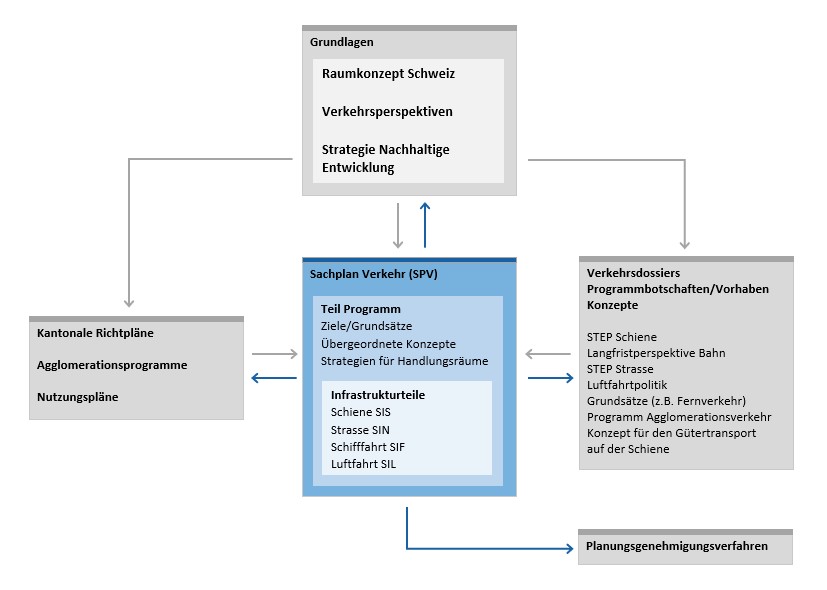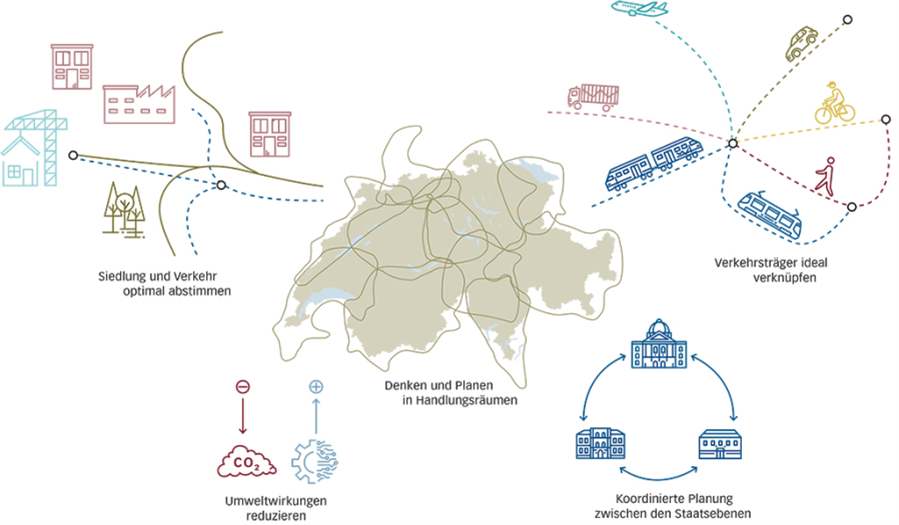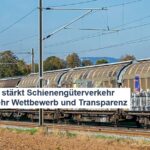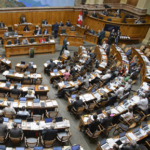The background in advance
Various factors have an impact on the Sectoral Plan for Transport/Programme section and thus on the future of rail freight transport (cf. Figure 1). The Swiss Spatial Development Perspective, the Transport Perspectives and the Sustainable Development Strategy provide the strategic direction. At the implementation level, the sectoral plans, transport sectoral plan/part of implementation, agglomeration programmes as well as the expansion steps for rail and road and other bases come into play.

Figure 1: Integration and interaction of the Sectoral Plan for Transport, Programme Section with the spatial and transport planning instruments (Source: Federal Office for Spatial Development ARE, Sectoral Plan for Transport, Programme Section)
With the long-term perspective RAIL 2050, the Federal Department of the Environment, Transport, Energy and Communications (DETEC) will define the relevant directions for national and international passenger and freight transport by rail and for the railway infrastructure from the existing strategies as a basis for the next STEP expansion steps. However, RAIL 2050 is not a mobility strategy for all modes of transport.
With the Sectoral Plan for Transport, part of the programme, DETEC ensures the coordination of the transport modes road, rail, air and water with each other and with spatial development. Spatial concerns are the main focus here. The Sectoral Plan for Transport consists of a programme section, which addresses the strategy level and was last updated by the Federal Council on 20 October 2021, and various implementation sections relating to the modes of transport.
The development of settlements and transport infrastructures go hand in hand. The settlement structure affects the transport system – and vice versa. The shape of the transport networks influences the location choices of companies and people, so they shape the space. The spatial patterns in turn affect traffic flows and network utilisation. For the further development of the transport system and for coordination with spatial development, the Spatial Concept Switzerland of 15 December 2012 suggests combining modes of transport according to their strengths and developing settlements in those areas where there are already good public transport connections, such as in agglomerations, in cities or in regional centres.
A total growth of 45 percent is forecast for freight transport by 2040. If the expansion of the rail infrastructure were to be dispensed with, the accessibility of the cities and centres of the metropolitan areas could deteriorate. With the STEP Expansion Step 2035, the financing of the infrastructures is ensured above all in the east-west corridor, the Lake Geneva region and the Zurich and Central Switzerland areas. In addition, freight transport facilities will be expanded. In freight transport in general and especially during rush hour, additional capacities will be created and transport speeds increased. This supports the efforts for self-sustained operation, especially in freight transport in the area.
On 26 January 2022, DETEC adopted the Sectoral Plan for Transport, Rail Infrastructure Part. This identifies approaches to solving problems in the area of rail infrastructure, provides for federal measures and sets out how these measures are to be coordinated with each other and with other spatially effective activities over time. These measures concern the following areas:
- Rail routes relevant to the sectoral plan
- Transhipment facilities for combined transport of national importance
- Passenger stations, stabling facilities, maintenance and service facilities for rolling stock or freight transport facilities on the standard and narrow-gauge network co-financed by the federal government.
- Transmission lines for the power supply of the railway network
- Substations necessary for the commissioning of important infrastructure extensions
What we think of the matter
DETEC and the Federal Office for Spatial Development (ARE) submitted the revision of the Sectoral Plan for Transport, Part Programme, for consultation on 15 September 2020. You can find our response here. We from the VAP are also represented on the Sounding Board for the development of DETEC’s long-term perspective for RAIL 2050 and have been able to contribute to the work on various occasions. Below we have summarised our most important suggestions for improving the sectoral plan, programme section.

Figure 2: The Sectoral Plan for Transport, part of the programme, gives more – though not enough – importance to freight transport. (Source: Federal Office for Spatial Development ARE, Sectoral Plan for Transport, Part of the Programme)
1. General comments
The sectoral plan consistently follows a top-down approach. This excludes potential sustainable scenarios for a bottom-up approach. Such would offer a greater right of co-determination for the cantons, communes and private actors concerned. This top-down approach is in contradiction to the recognition that “the forms of supply and the providers are diverse” (cf. page 24). The definitive version adheres to the state levels and excludes the economy.
One of the most important goals is to achieve the CO2 targets. Unfortunately, the sectoral plan does not sufficiently reflect the current developments of the transport modes. For example, the complete abandonment of petrol engines by the automotive industry from 2030 or the use of the most modern traffic guidance systems in connection with (partially) autonomous driving and thus better use of the infrastructure.
VAP proposal: The Sectoral Plan should take better account of “green” logistics as the backbone of the Swiss economy and the basis for the secure prosperity of the Swiss population.
2. Counterflow principle endangered
In the chapters “Mobility and Spatial Objectives” and “Development Strategies and Principles for Action”, the Sectoral Plan contains highly detailed, binding provisions for the authorities. However, this severely restricts the iterative cooperation of all levels of government, which is also described in detail in the sectoral plan, and the countercurrent principle that it refers to. The sectoral plan pursues a centralist – not a federalist – approach without a legal basis.
Proposal VAP: The level of detail of the specifications, considerations and explanations binding on the authorities offers little room for cooperation in the sense of the counterflow principle. To facilitate interregional strategies, the Confederation could undertake an overall coordination.
3. Conflict of objectives between public transport and rail freight transport
The Sectoral Plan lacks a detailed differentiation between passenger and freight transport and the associated challenges and potential future solutions. Furthermore, the Sectoral Plan speaks of public transport as the opposite of private motorised transport. This view does not go far enough for rail freight transport, as the latter does not count as public transport.
VAP proposal: The adopted version of the sectoral plan does give rail freight transport a higher priority. However, public transport considerations still dominate. The representatives of rail freight transport, like those of public transport, should be included in the iterative processes of the state levels described. 4.
4. Private companies excluded
The sectoral plan was developed by the federal government, cantons, cities/municipalities and representatives of the agglomeration authorities. The infrastructure that is indispensable for freight transport (transhipment platforms, terminals, sidings, port infrastructure on inland waterways, air freight terminals, etc.) is built and maintained by the private sector. The sectoral plan summarises this private infrastructure under the term “transport hubs and development focal points”. Freight traffic is handled via these in multimodal logistics chains. Nevertheless, freight transport is not included in the proposed typology of transport hubs. Companies” are understood to mean public transport companies, not the private sector shippers who build, finance and operate the hubs. The latter should not be involved.
Proposal VAP: Successful, innovative, customer-oriented and thus sustainable mobility or the broad acceptance of offers can only be realised by involving the private companies involved. These must be involved in the implementation of the objectives of the sectoral plan for questions of traffic management, better capacity utilisation, increased efficiency and increased resilience of the transport hubs.
5. Infrastructure development not very demand-oriented
The proposal to specify that all other possibilities for good connections should first be exhausted before expansion makes the neglect of freight transport in the sectoral plan abundantly clear. There is no mention of production and logistics locations. Freight transport hubs remain irrelevant. Rail freight transport is discussed very cautiously in the sectoral plan and is not perceived as a transport hub or development focus.
The proposal to deal with freight transport alone in the “Freight Transport by Rail Concept” is insufficient. This is for two reasons: The share of rail freight transport in domestic traffic is only just under 20%. Moreover, the concept is under the overarching umbrella of the sectoral plan, which means that it lacks the level justice and binding nature.
VAP proposal: The Sectoral Transport Plan must not neglect freight transport and exclude the main private-sector actors. Otherwise, infrastructure development will not be demand-oriented.
6. Optimise the quality of connections
The central east-west axis for rail freight transport is predominantly located in the intermediate settlement area. Extensive production, processing and logistics locations as well as transport hubs (sidings, terminals) are located here. Their regional connection to long-distance freight transport between agglomerations, but also within or between agglomeration belts, is not described in the sectoral plan. In particular, no tangential connections bypassing the agglomeration cores are shown, although such a connection is planned in the action areas, for example with the Zurich freight bypass line. No tangential lines or outer belts are shown for public transport either, although the negative effects of congestion in the agglomeration cores are known and the sectoral plan assumes a significant shift in traffic.
Proposal VAP: The connection quality oriented towards public transport should be supplemented with differentiated spatial types for rail freight transport. Likewise, the bypassing of congested agglomeration cores through public transport connections between agglomerations and within agglomerations via tangential lines and bypass belts.
7. Regulate the transport of hazardous goods separately
The Sectoral Plan does not adequately address the conflict of objectives between environmental protection (accident prevention, modal shift to rail freight transport) and densification in the centres. Densification changes the risk assessment in the transport of dangerous goods. This means that risk-reducing measures may be necessary to maintain existing transport operations. In doing so, the polluter pays principle must be respected so that rail freight transport can not only be maintained, but also increased as envisaged.
The problem can be prototypically illustrated by a possible ban on the transport of hazardous goods on the Simplon. The Simplon is the best developed pass in Switzerland. An enormous amount of money has been invested in recent years to increase its safety. According to Article 4 of the “Ordinance on the Transport of Dangerous Goods by Road” (SDR), the provisions of the “Agreement concerning the International Carriage of Dangerous Goods by Road” (ADR) also apply to the transport of dangerous goods by road in national traffic. Domestic traffic on the Simplon is not relevant in terms of volume, as this is practically only international traffic.
Suggestion for improvement: Our request for a separate consideration of dangerous goods was included in the sectoral plan. However, without any reference to causation and levying of added value, but only in the sense of “forward-looking” planning. The connection between modal shift to rail freight transport and densified settlement in the case of hazardous goods transports must be presented, taking environmental concerns into account. This requires solutions that are fair to the polluter.
You can read the full text of our written hearing response to Federal Councillor Simonetta Sommaruga here.
Vorschlag VAP: Der Sachplan Verkehr darf den Güterverkehr nicht vernachlässigen und die privatwirtschaftlichen Hauptakteure ausklammern. Ansonsten erfolgt der Infrastrukturausbau nicht nachfrageorientiert.
6. Verbindungsqualität optimieren
Die für den Schienengüterverkehr zentrale Ost-West-Achse liegt überwiegend im intermediären Siedlungsraum. Hier befinden sich umfangreiche Produktions‑, Verarbeitungs- und Logistikstandorte sowie Verkehrsdrehscheiben (Anschlussgleise, Terminals). Ihre regionale Anbindung an den Güterfernverkehr zwischen Agglomerationen, aber auch innerhalb oder zwischen Agglomerationsgürteln, wird im Sachplan nicht beschrieben. Insbesondere werden keine Tangentialverbindungen unter Umfahrung der Agglomerationskerne aufgezeigt, obschon eine solche zum Beispiel mit der Güterumfahrungslinie Zürich in den Handlungsräumen vorgesehen ist. Auch für den öffentlichen Verkehr werden keine Tangentiallinien oder äussere Gürtel aufgezeigt, obschon die negativen Auswirkungen der Überlastung der Agglomerationskerne bekannt sind und der Sachplan von einer markanten Verkehrsverlagerung ausgeht.


